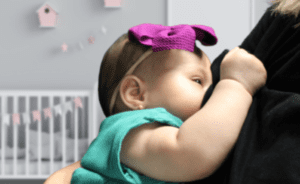Simple Foundational Breastfeeding Tips
Tips from a Speech-Language Pathologist and Lactation Counselor
Breastfeeding is natural but is not always intuitive! Babies are capable and love to nurse however the breastfeeding dyad must learn to breast feed collaboratively. Establishing a good partnership for nursing, at the time of birth, can help with building positive and effective patterns for nursing at the breast long term.
General considerations:
– There should not be pain during nursing, at any point. Additionally, breasts after feeding should not be bruised, misshapen, blanched, etc. as that is indication of an incorrect latch.
– Crying is a late feeding cue that is used when early feeding cues have been missed. Earlier feeding cues prior to crying include:
-
- Rooting: turning the head/searching movements of the mouth
- Increasing alertness, specifically REM (rapid eye movement) under closed eyelids
- Flexing of the arms and legs with sucking motions of the mouth
- Bringing hands to mouth and sucking on fist or fingers
- Mouthing motions of the lips and tongue

‘
– It is also important to understand when your baby is full after a nursing session. Feeding fullness cues include:
-
-
- Baby is relaxed-hands are open and not clenched
- Arms are floppy
- Brow is smooth
- Toes are curled
- Baby’s hands and arms should not be moved away from the breast or anchored down by a swaddle during breastfeeding, as they should encircle the breast during suckling.
-
– Baby’s hands and arms should not be moved away from the breast or anchored down by a swaddle during breastfeeding, as they should encircle the breast during suckling.
– Do not force the baby to the breast, as this may cause stress to the baby and make them unwilling to latch
The Sequence of a successful feeding at the breast:
- Ideally, the newborn is held skin-to-skin so that feeding cues may be observed
- Baby is brought to the breast as soon as early feeding cues are observed
- Breast should fall at its normal angle (not held or shaped with the hand)
- Baby is supported by the frame of the parent’s body
- Baby is allowed the freedom to achieve pain-free suckling with maximal milk transfer

‘
Understanding the foundation of establishing a good latch is helpful for building a long-term, successful, and collaborate breastfeeding relationship between baby and feeder. If you are seeking additional guidance and support for your child’s breast feeding skills, our lactation counselors at CPTWC are here to help! Call today at 773-687-9241 to schedule with one of our specialists!


